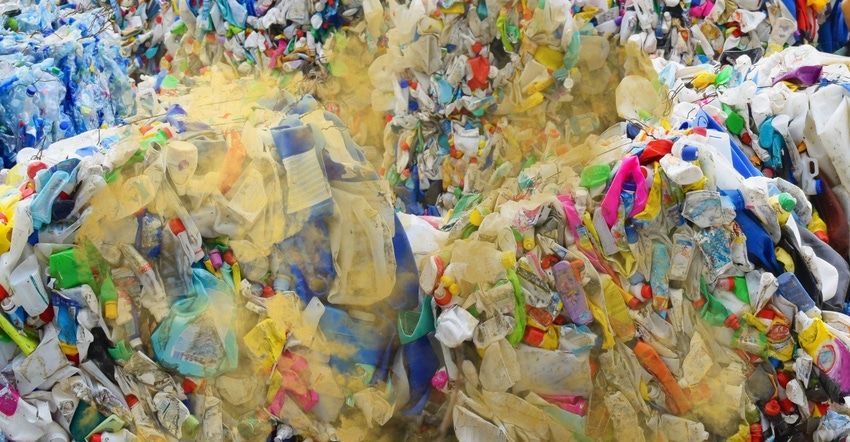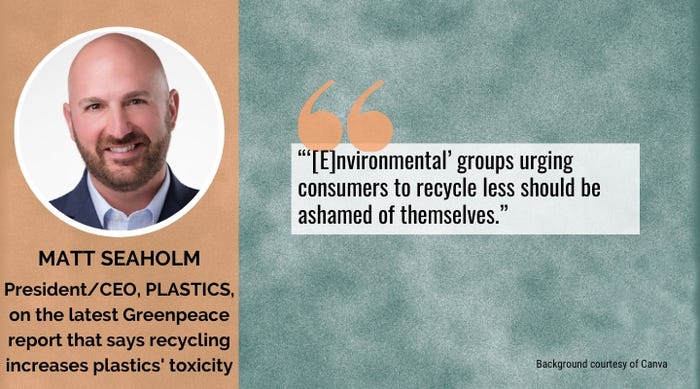Greenpeace: Recycling Increases the Toxicity of Plastics
With the planet at stake, environmental activists say the promise of advanced recycling isn’t enough to save plastic packaging. We must end production of plastics or suffer dire consequences.

Environmentalists at Greenpeace fired a nuke in the war on plastics with the release of its latest report on May 24, 2023. It’ll come as no surprise that the organization concludes that plastics are poison, and we should cap how much is made as a first step on the way to ending them altogether.
But what might be quite shocking is the report also says recycling won’t help save plastics, not even chemical/advanced recycling. Because, the report claims, research shows that recycling actually increases the toxicity of plastics, making them worse than they already are.
The report’s timing relates to the upcoming treaty talks.
The report , which you can download for free, is called “Forever Toxic: The science of health threats from plastic recycling.” Its release was timed to be right before the Global Plastics Treaty negotiations resume in Paris (May 29 to June 2). Ultimately, Greenpeace wants the treaty to “focus on capping and then phasing down plastic production.”
But the report identifies seven action points Greenpeace wants from the Global Plastics Treaty:
1. Achieve immediate, significant reductions in plastic production, establishing a pathway to end virgin plastic production.
2. Promote a shift to refill- and reuse-based economies, creating jobs and standards in new reuse industries and supporting established zero-waste practices.
3. Support a just transition for workers across the plastics supply chain, prioritizing waste pickers who collect approximately 60% of all plastic that is collected for recycling globally.
4. Promote non-combustion technologies for plastic stockpiles and waste disposal.
5. Institute the “polluter pays” principle for plastic waste management and for addressing the health and environmental costs throughout the plastics life cycle.
6. Significantly improve regulation, oversight, safety, and worker protections for existing recycling facilities.
7. Require transparency about chemicals in plastics and eliminate all toxic additives and chemicals used in the plastics life cycle.
Extensive research supports toxicity claims.
Highly annotated with 51 citations, the report relies on existing research that supports the report’s claims. For example, the report identifies three “uncontrollable poisonous pathways of plastic recycling.”
1. Toxic chemicals in new virgin plastic materials.
2. Leaching of toxic substances into plastic waste.
3. New toxic chemicals created by the recycling process.
This last item was news to me, and I need to learn more. But the report specifies: “When plastics are heated in the recycling process, this can generate new toxic chemicals that make their way into the recycled plastics. For example, brominated dioxins are created when plastics containing brominated flame retardants are recycled,[1] and a stabilizer used in plastic recycling can degrade to a highly toxic substance found in recycled plastics.[2] Sorting challenges and the presence of certain packaging components in sorted materials can also lead to toxicity in recycled plastic. Studies have shown that benzene (a carcinogen) can be created by mechanical recycling of PET#1 plastic, even with very low rates of contamination by PVC#3 plastic, resulting in the cancer-causing chemical being found in recycled plastics.[3]”
A point about these studies … I haven’t read them in their entirety. But saying something can happen and proving that it does happen are two very different things.
And if toxicity does appear in the recycled plastic material, what are the thresholds and do those thresholds exceed safety levels set by regulatory groups?
Greenpeace attempts to strike a death blow to plastics by attacking recycling.
Recycling rates for plastic packaging are dismal globally. “Only 9% of plastic waste is recycled (15% is collected for recycling but 40% of that is disposed of as residues) …” according to the Organisation for Economic Co-operation and Development (OECD).
The reasons for these disappointing numbers are varied. But increasing those numbers is going slowly. Collection and sortation prove … challenging.
Some in the plastic packaging industry look to the newer technologies for advanced (aka chemical) recycling as possible saviors. These solutions could remove and reuse a significant amount of plastics currently going to landfill.
But with this report, Greenpeace is trying to pop that advanced recycling bubble before it inflates further. Graham Forbes, Global Plastics Campaign Lead at Greenpeace USA, says in the press release about the report: “The plastics industry — including fossil fuel, petrochemical, and consumer goods companies — continues to put forward plastic recycling as the solution to the plastic pollution crisis. But this report shows that the toxicity of plastic actually increases with recycling. Plastics have no place in a circular economy and it’s clear that the only real solution to ending plastic pollution is to massively reduce plastic production.”
The plastics industry sees it differently, of course.
What about the opposite side? What do people in the plastics industry think of this news and data?

Packaging Digest asked the Plastics Industry Association (PLASTICS) to comment on the Greenpeace report. Here’s what Matt Seaholm, President/CEO of PLASTICS, had to say: “Greenpeace has established themselves as an anti-recycling organization and is not a credible voice in this discussion; ‘environmental’ groups urging consumers to recycle less should be ashamed of themselves. The hyperbole surrounding studies that are morphed to raise money from innocent donors who care about our environmental challenges has become rampant and, sadly, typical.
“Our member companies work every single day to solve problems for consumers in the most sustainable way. Once Greenpeace recognizes plastic is an essential material in our lives that keeps us protected and safe, and ends their fearmongering, then we can talk about real public policy solutions.
“Plastics have been demonstrated over and over again to be safe. They are heavily regulated by competent authorities like the FDA and broad assertions that they are made ‘from toxic chemicals’ are fearmongering and deterring the public from doing the right thing, which is recycling and reusing plastic.”
Our sister publication PlasticsToday quotes Joshua Baca, Vice President of Plastics at the American Chemistry Council (ACC): “If Greenpeace had its way, modern life would be dramatically different. People across the world, particularly in developing countries, would have less access to clean drinking water, safe food supplies, sanitary medical and personal care products, and renewable energy. The proposals in their report would disrupt global supply chains, hinder sustainable development, and substitute plastics with materials that have a much higher carbon footprint in critical applications.”
Possible future?
While I think the likelihood of caps on plastics production is low, I can’t rule it out. I also didn’t think extended producer responsibility programs would find a foothold in the US, but Oregon and Maine proved me wrong. The appetite for sustainability today is at feast-and-drunkenness level. And plastic packaging is often seen as the main course.
[1] Petrlík, J., Beeler, B., Strakova, J., Allo’o Allo’o, S.M., Amera, T., Brosche, S., Gharbi, S. ... Zulkovska, K. 2022. Hazardous Chemicals in Plastic Products. IPEN & Arnika. https://ipen.org/documents/hazardous-chemicals-plastic-products
[2] Rung, C., Welle, F., Gruner, A., Springer, A., Steinmetz, Z. & Munoz, K. 2023. Identification and Evaluation of (Non-)Intentionally Added Substances in Post-Consumer Recyclates and Their Toxicological Classification. Recycling 8(1): 24. https://doi.org/10.3390/recycling8010024
[3] Alvarado Chacon, F., Brouwer, M. & van Velzen, E. 2020. Effect of Recycled Content and rPET Quality on the Properties of PET Bottles, Part I: Optical and Mechanical Properties. Packaging Technology and Science 33(2): 347–357. http://dx.doi.org/10.1002/pts.2490
About the Author(s)
You May Also Like




